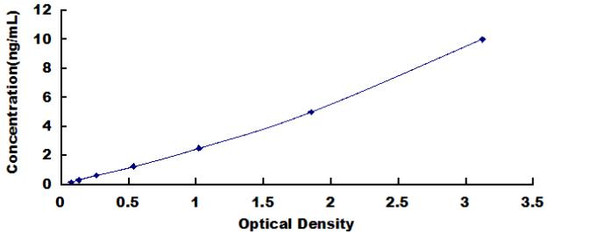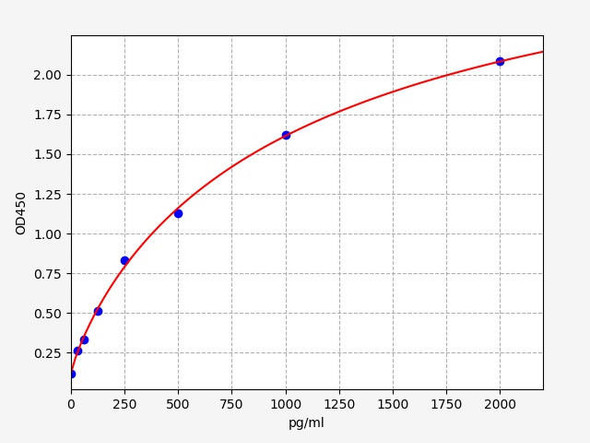Human MASP2 (Mannan Associated Serine Protease 2) ELISA Kit (HUES03258)
- SKU:
- HUES03258
- Product Type:
- ELISA Kit
- Size:
- 96 Assays
- Uniprot:
- O00187
- Sensitivity:
- 1.88ng/mL
- Range:
- 3.13-200ng/mL
- ELISA Type:
- Sandwich
- Synonyms:
- Mannan-Binding Lectin Serine Peptidase 2
- Reactivity:
- Human
- Sample Type:
- Serum, plasma and other biological fluids
- Research Area:
- Immunology
Description
Human MASP2 (Mannan Associated Serine Protease 2) ELISA Kit
The Human MASP2 (Mannan-Binding Lectin Serine Protease 2) ELISA Kit is specifically designed for the accurate detection of MASP2 levels in human serum, plasma, and cell culture supernatants. This kit offers high sensitivity and specificity, ensuring reliable and reproducible results for a variety of research applications.MASP2 is a key protein involved in the lectin pathway of the complement system, playing a critical role in innate immunity and inflammation. Dysregulation of MASP2 has been linked to various autoimmune diseases, infections, and inflammatory conditions, making it a valuable biomarker for studying these diseases and potential therapeutic targets.
By using the Human MASP2 ELISA Kit, researchers can accurately measure MASP2 levels in biological samples, providing valuable insights into the role of this protein in health and disease. With its high-quality components and easy-to-follow protocol, this kit is a valuable tool for advancing research in immunology, inflammation, and related fields.
| Assay type: | Sandwich |
| Format: | 96T |
| Assay time: | 4.5h |
| Reactivity: | Human |
| Detection Method: | Colormetric |
| Detection Range: | 3.13-200 ng/mL |
| Sensitivity: | 1.88 ng/mL |
| Sample Volume Required Per Well: | 100µL |
| Sample Type: | Serum, plasma and other biological fluids |
| Specificity: | This kit recognizes Human MASP2 in samples. No significant cross-reactivity or interference between Human MASP2 and analogues was observed. |
This ELISA kit uses Sandwich-ELISA as the method. The micro ELISA plate provided in this kit has been pre-coated with an antibody specific to Human MASP2. Standards or samples are added to the appropriate micro ELISA plate wells and combined with the specific antibody. Then a biotinylated detection antibody specific for Human MASP2 and Avidin-Horseradish Peroxidase (HRP) conjugate are added to each micro plate well successively and incubated. Free components are washed away. The substrate solution is added to each well. Only those wells that contain Human MASP2, biotinylated detection antibody and Avidin-HRP conjugate will appear blue in color. The enzyme-substrate reaction is terminated by adding Stop Solution and the color turns yellow. The optical density (OD) is measured spectrophotometrically at a wavelength of 450 nm ± 2 nm. The OD value is proportional to the concentration of Human MASP2. The concentration of Human MASP2 in samples can be calculated by comparing the OD of the samples to the standard curve.
| UniProt Protein Function: | MASP2: Serum protease that plays an important role in the activation of the complement system via mannose-binding lectin. After activation by auto-catalytic cleavage it cleaves C2 and C4, leading to their activation and to the formation of C3 convertase. Defects in MASP2 are the cause of MASP2 deficiency (MASPD). MASPD is a disorder that results in autoimmune manifestations, recurrent severe infections, and chronic inflammatory disease. Belongs to the peptidase S1 family. 2 isoforms of the human protein are produced by alternative splicing. |
| UniProt Protein Details: | Protein type:EC 3. 4. 21. 104; Protease; Secreted, signal peptide; Secreted Chromosomal Location of Human Ortholog: 1p36. 3-p36. 2 Cellular Component: extracellular region Molecular Function:peptidase activity; protein binding; serine-type endopeptidase activity; complement component C4b binding; calcium ion binding; calcium-dependent protein binding Biological Process: innate immune response; complement activation, lectin pathway; proteolysis; complement activation, classical pathway; complement activation Disease: Masp2 Deficiency |
| NCBI Summary: | The Ra-reactive factor (RARF) is a complement-dependent bactericidal factor that binds to the Ra and R2 polysaccharides expressed by certain enterobacteria. Alternate splicing of this gene results in two transcript variants encoding two RARF components that are involved in the mannan-binding lectin pathway of complement activation. The longer isoform is cleaved into two chains which form a heterodimer linked by a disulfide bond. The encoded proteins are members of the trypsin family of peptidases. [provided by RefSeq, Jul 2008] |
| UniProt Code: | O00187 |
| NCBI GenInfo Identifier: | 21264363 |
| NCBI Gene ID: | 10747 |
| NCBI Accession: | NP_006601. 2 |
| UniProt Secondary Accession: | O00187,O75754, Q5TEQ5, Q5TER0, Q96QG4, Q9BZH0, Q9H498 Q9H499, Q9UBP3, Q9UC48, A8K458, A8MWJ2, |
| UniProt Related Accession: | O00187 |
| Molecular Weight: | 76 kDa |
| NCBI Full Name: | mannan-binding lectin serine protease 2 isoform 1 preproprotein |
| NCBI Synonym Full Names: | mannan-binding lectin serine peptidase 2 |
| NCBI Official Symbol: | MASP2 |
| NCBI Official Synonym Symbols: | sMAP; MAP19; MASP-2; MASP1P1 |
| NCBI Protein Information: | mannan-binding lectin serine protease 2 |
| UniProt Protein Name: | Mannan-binding lectin serine protease 2 |
| UniProt Synonym Protein Names: | MBL-associated serine protease 2; Mannose-binding protein-associated serine protease 2; MASP-2 |
| Protein Family: | Mannan-binding lectin serine protease |
| UniProt Gene Name: | MASP2 |
| UniProt Entry Name: | MASP2_HUMAN |
As the OD values of the standard curve may vary according to the conditions of the actual assay performance (e. g. operator, pipetting technique, washing technique or temperature effects), the operator should establish a standard curve for each test. Typical standard curve and data is provided below for reference only.
| Concentration (ng/mL) | O.D | Average | Corrected |
| 200 | 2.273 2.273 | 2.273 | 2.212 |
| 100 | 1.521 1.531 | 1.526 | 1.465 |
| 50 | 0.86 0.848 | 0.854 | 0.793 |
| 25 | 0.476 0.494 | 0.485 | 0.424 |
| 12.5 | 0.24 0.216 | 0.228 | 0.167 |
| 6.25 | 0.159 0.153 | 0.156 | 0.095 |
| 3.13 | 0.103 0.117 | 0.11 | 0.049 |
| 0 | 0.058 0.064 | 0.061 | -- |
Precision
Intra-assay Precision (Precision within an assay): 3 samples with low, mid range and high level Human MASP2 were tested 20 times on one plate, respectively.
Inter-assay Precision (Precision between assays): 3 samples with low, mid range and high level Human MASP2 were tested on 3 different plates, 20 replicates in each plate.
| Intra-assay Precision | Inter-assay Precision | |||||
| Sample | 1 | 2 | 3 | 1 | 2 | 3 |
| n | 20 | 20 | 20 | 20 | 20 | 20 |
| Mean (ng/mL) | 10.31 | 17.89 | 76.60 | 10.05 | 17.98 | 83.08 |
| Standard deviation | 0.60 | 0.73 | 3.07 | 0.58 | 1.06 | 4.25 |
| C V (%) | 5.82 | 4.08 | 4.01 | 5.77 | 5.90 | 5.12 |
Recovery
The recovery of Human MASP2 spiked at three different levels in samples throughout the range of the assay was evaluated in various matrices.
| Sample Type | Range (%) | Average Recovery (%) |
| Serum (n=5) | 92-105 | 97 |
| EDTA plasma (n=5) | 90-104 | 97 |
| Cell culture media (n=5) | 87-100 | 94 |
Linearity
Samples were spiked with high concentrations of Human MASP2 and diluted with Reference Standard & Sample Diluent to produce samples with values within the range of the assay.
| Serum (n=5) | EDTA plasma (n=5) | Cell culture media (n=5) | ||
| 1:2 | Range (%) | 87-101 | 87-100 | 90-104 |
| Average (%) | 92 | 93 | 95 | |
| 1:4 | Range (%) | 88-99 | 81-95 | 88-102 |
| Average (%) | 93 | 87 | 95 | |
| 1:8 | Range (%) | 86-101 | 80-92 | 89-100 |
| Average (%) | 93 | 85 | 95 | |
| 1:16 | Range (%) | 91-109 | 85-100 | 89-101 |
| Average (%) | 99 | 92 | 94 |
An unopened kit can be stored at 4°C for 1 month. If the kit is not used within 1 month, store the items separately according to the following conditions once the kit is received.
| Item | Specifications | Storage |
| Micro ELISA Plate(Dismountable) | 8 wells ×12 strips | -20°C, 6 months |
| Reference Standard | 2 vials | |
| Concentrated Biotinylated Detection Ab (100×) | 1 vial, 120 µL | |
| Concentrated HRP Conjugate (100×) | 1 vial, 120 µL | -20°C(shading light), 6 months |
| Reference Standard & Sample Diluent | 1 vial, 20 mL | 4°C, 6 months |
| Biotinylated Detection Ab Diluent | 1 vial, 14 mL | |
| HRP Conjugate Diluent | 1 vial, 14 mL | |
| Concentrated Wash Buffer (25×) | 1 vial, 30 mL | |
| Substrate Reagent | 1 vial, 10 mL | 4°C(shading light) |
| Stop Solution | 1 vial, 10 mL | 4°C |
| Plate Sealer | 5 pieces | |
| Product Description | 1 copy | |
| Certificate of Analysis | 1 copy |
- Set standard, test sample and control (zero) wells on the pre-coated plate and record theirpositions. It is recommended to measure each standard and sample in duplicate. Note: addall solutions to the bottom of the plate wells while avoiding contact with the well walls. Ensuresolutions do not foam when adding to the wells.
- Aliquot 100µl of standard solutions into the standard wells.
- Add 100µl of Sample / Standard dilution buffer into the control (zero) well.
- Add 100µl of properly diluted sample (serum, plasma, tissue homogenates and otherbiological fluids) into test sample wells.
- Cover the plate with the sealer provided in the kit and incubate for 90 min at 37°C.
- Aspirate the liquid from each well, do not wash. Immediately add 100µL of BiotinylatedDetection Ab working solution to each well. Cover the plate with a plate seal and gently mix. Incubate for 1 hour at 37°C.
- Aspirate or decant the solution from the plate and add 350µL of wash buffer to each welland incubate for 1-2 minutes at room temperature. Aspirate the solution from each well andclap the plate on absorbent filter paper to dry. Repeat this process 3 times. Note: a microplatewasher can be used in this step and other wash steps.
- Add 100µL of HRP Conjugate working solution to each well. Cover with a plate seal andincubate for 30 min at 37°C.
- Aspirate or decant the solution from each well. Repeat the wash process for five times asconducted in step 7.
- Add 90µL of Substrate Reagent to each well. Cover with a new plate seal and incubate forapproximately 15 min at 37°C. Protect the plate from light. Note: the reaction time can beshortened or extended according to the actual color change, but not by more than 30min.
- Add 50 µL of Stop Solution to each well. Note: Adding the stop solution should be done inthe same order as the substrate solution.
- Determine the optical density (OD value) of each well immediately with a microplate readerset at 450 nm.










